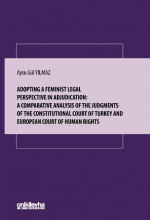 Legal systems, reflecting the dominant ideology present in societies, perpetuate patriarchal values and gendered power hierarchies. In this context, the judiciary and especially judges, are in a position to ameliorate this situation, both owing to their significant social role as State agents and subsequently their responsibilities with regards to the protection and effective realization of human rights. However, the conduct of judges may present barriers for access to justice on the basis of gender, especially through judicial stereotyping practices. This work will therefore suggest that a gender-conscious approach to judicial decision-making will improve the legal system and help it function free from bias. The proposed method for this is the incorporation of feminist legal methodologies, as will be showcased through a comprehensive and comparative analysis of the decisions of both the Constitutional Court of Turkey and European Court of Human Rights.(ARKA KAPAKTAN)
Legal systems, reflecting the dominant ideology present in societies, perpetuate patriarchal values and gendered power hierarchies. In this context, the judiciary and especially judges, are in a position to ameliorate this situation, both owing to their significant social role as State agents and subsequently their responsibilities with regards to the protection and effective realization of human rights. However, the conduct of judges may present barriers for access to justice on the basis of gender, especially through judicial stereotyping practices. This work will therefore suggest that a gender-conscious approach to judicial decision-making will improve the legal system and help it function free from bias. The proposed method for this is the incorporation of feminist legal methodologies, as will be showcased through a comprehensive and comparative analysis of the decisions of both the Constitutional Court of Turkey and European Court of Human Rights.(ARKA KAPAKTAN)
TABLE OF CONTENTS
INTRODUCTION
CHAPTER I
PRESENTING A THEORETICAL ACCOUNT OF THE JUDICIAL RESPONSIBILITY TO REALIZE GENDER EQUALITY
I. The Role of Judges in Realizing Gender Equality
A. Conceptual Framework to Explain the Fundamental Role of Judges
1. Judicial Ethics
2. Conclusion
B. Practical Problems Arising from Failure to Follow the Principles of Judicial Ethics
1. Access to Justice
2. Politization of Judiciary
3. Conclusion
II. Legal Framework Regarding the Role of Judges as a Human Rights Protection Mechanism
A. National Legislation to Illustrate the Role of Judges
1. Primary Legislation
2. Secondary Legislation
B. International Legal Framework to Illustrate the Role of Judges
1. United Nations Texts
2. Council of Europe Texts
C. Conclusion
III. Feminist Legal Theory to Provide a New Approach to Adjudication
A. Feminist Legal Theory
1. Central Concepts and Questions in Feminist Legal Theory
2. The State is Male: Gendered Essence of the Sovereign State Power
3. International Law is Male: The Struggle to Position Women's Rights As Human Rights
B. Feminist Methodology
1. Feminist Research Methods
2. Feminist Legal Methodology
C. Conclusion
CHAPTER II
A GENDER CONSCIOUS PERSPECTIVE IN THE PRACTICE OF THE JUDICIARY
I. Introduction to Gender Perspective in Practice: Case Law
II. Constitutional Court of Turkey's Approach to Cases Concerning Gender
A. Gender Stereotypes and Violence
B. Gender Stereotypes and Autonomy
1. Honor
2. Sexual Violence
3. Issues Regarding Bodily Integrity, Birth and Abortion
4. Recognition of Gender Identity
C. Stereotypes and Sexual Orientation and Gender Identity (SOGI)
D. Gender Stereotypes and Family
1. Adultery or Extra-Marital Affairs
2. The Issue of the Paternal Surname
3. Permission to Work
4. Gender Stereotypes and Socio-economic Status
III. European Court of Human Rights's Approach to Cases Concerning Gender
A. Gender Stereotypes and Gender Based Violence
B. Gender Stereotypes and Bodily Autonomy
1. Sexual Violence
2. Issues Regarding Bodily Integrity and Abortion
3. Body Politics
4. Gender Stereotypes and Gender Identity
C. Gender and Socio-economic Rights
D. Gender Stereotypes on Race and Ethnicity
E. Gender Stereotypes and Religion
F. Gender Stereotypes and Family
G. Gender Stereotypes and Sexual Orientation and Gender Identity (SOGI)
IV. Gender Perspective and Its Practical Implications: An Evaluation of the Responsibility of the Judges
CONCLUSION
BIBLIOGRAPHY
